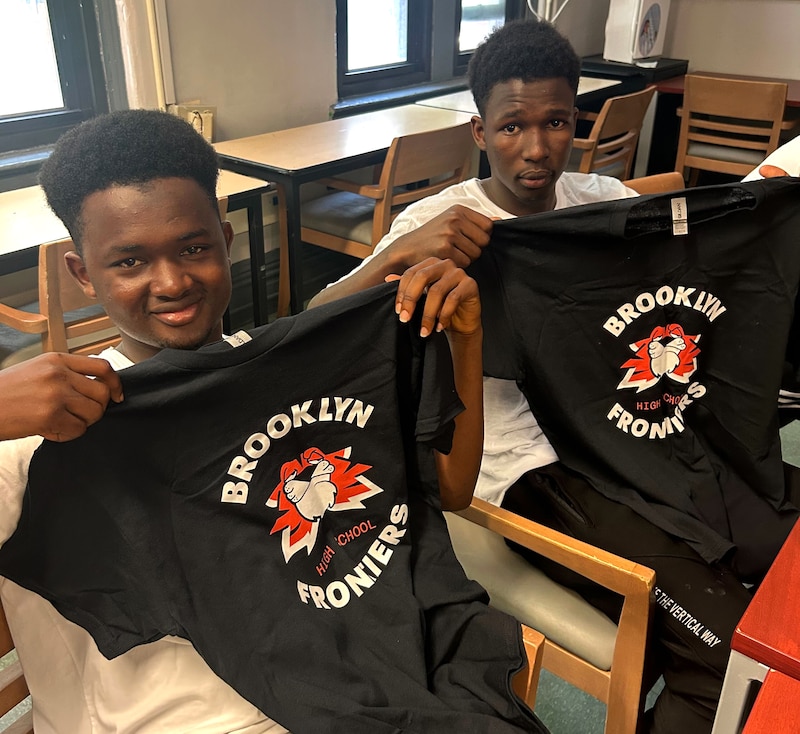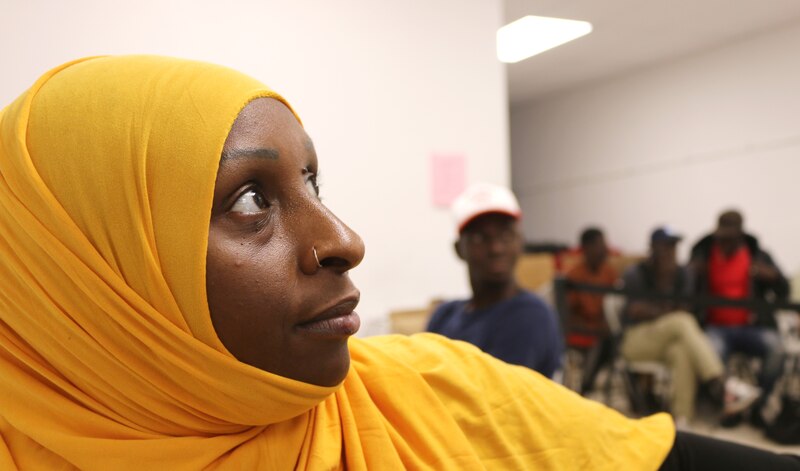The prospect of enrolling at a New York City school had begun to seem like a dim possibility for Amadou Sara Barry, an 18-year-old who arrived from Guinea five months ago.
Barry came to the U.S. by himself in February, determined to attend school to learn English and take the first step toward his dream of becoming an actor, he told Chalkbeat through an interpreter speaking Pulaar, an indigenous language of Guinea. But he’d hit a wall. Some schools told him he was too old, and others told him to come back in the fall, he said.
Under state law, students like Barry are allowed to attend public school through age 21. Yet he wasn’t alone in his struggles.
Few older immigrant students like Barry know where to begin the enrollment process. Those who do manage to make their way to schools or enrollment centers often wind up with referrals to schools that are ill-equipped to serve them or have no more room, advocates said. Others are directed to classes outside of traditional high schools that prepare students to take the General Educational Development test, or GED, a high school equivalency exam. In response, some groups are trying to ensure these students aren’t ignored or shunted away from what they want.
That’s how Barry’s situation changed on a recent sweltering Friday afternoon, as he and a group of seven other Guinean immigrant students sat rapt around a conference table at Brooklyn Frontiers High School while Principal Alona Cohen explained the registration process.
Of these eight Guinean immigrants, ages 18-20, only one had managed to secure a spot in a school previously, said Maricruz Badia, a program coordinator with the nonprofit InsideSchools who accompanied the students on the visit.
The Brooklyn Frontiers trip was part of a growing grassroots effort led by organizations like InsideSchools as well as Afrikana, a Harlem nonprofit that supports African migrants, to improve the enrollment process for older immigrant youth and ensure they find appropriate school placements.
“There [is] this large community of unaccompanied older youth who … should be in schools but are having a very hard time finding schools,” said Badia, who’s leading a new initiative to support these young people.
The push relies in large part on schools like Brooklyn Frontiers, a small transfer school with about 110 students that specializes in supporting older students. Brooklyn Frontiers had not historically served many newly arrived immigrants. But Cohen, the principal, was eager to enroll more and had recently hired a new English as a Second Language teacher.
“There was a population shift in terms of the need, it was just as simple as that,” she said of the school’s adjustments to serve more new English learners.

The effort comes as a historic influx of migrant students into New York City enters its third year. So far, an estimated 40,000 immigrant students living in city homeless shelters have enrolled in school. Yet they often struggle to sign up even though there are plenty of open seats citywide.
Badia, a former Bronx middle school counselor who came to InsideSchools last year, was horrified to witness how difficult the basic task of enrolling in school proved for many of the older West African youth, in particular.
During one visit to an enrollment center in the Bronx, only students who brought transcripts from their home countries — documents that can be difficult to access for students who left in a hurry — were able to get school referrals, said Badia.
Anyone 18 and older was referred to the Education Department’s GED programs for 17-21 year-olds, she said.
An Education Department spokesperson said counselors at enrollment centers help older immigrant students choose between traditional high schools, transfer schools, international schools, and high school equivalency programs. The city expanded its GED classes and launched a new program called Young Adult Bridge that offers weeknight English classes to students ages 18-20 in response to surging demand, the spokesperson added.
“Our administration deeply believes that every child deserves the opportunity to succeed, no matter where they came from,” said Education Department spokesperson Nicole Brownstein.
But Badia said the way the system is currently operating, “it’s going to spit these young people right back out.” That frustration is what prompted her to try a new approach: building relationships directly with school leaders like Cohen. That way, Badia can bypass enrollment centers, and she knows she’s connecting kids to schools that have the willingness to serve them.
She was excited when an old friend who teaches at Brooklyn Frontiers mentioned that the school was hoping to enroll more English learners.
For Cohen, the budding collaboration with InsideSchools — an organization known for its school reviews — is a promising way to direct more older newcomers toward her school.
“They understand our capacity, what we specialize in, what we’re maybe not as strong in,” Cohen said.
And for the eight students, the visit was a chance to get their questions answered and connect with other Guinean immigrants who had been in their shoes months earlier. As they munched on pizza, the students asked Cohen, with the help of a Pulaar interpreter, where to send school records from Guinea, when to report for summer school, and how to access their free MetroCards.
Barry, the 18-year-old aspiring actor, was cautiously optimistic. He said he could see himself eventually making friends at Brooklyn Frontiers, but is still worried about getting to summer school in Manhattan.
Mostly, though, he was excited to finally have something to do during the day.
By the end of the two-hour visit, all eight students were enrolled.
Older immigrants struggle to find seats in NYC schools
The challenges for older immigrant students trying to enroll in school are pervasive and long-running.
A recent investigation by the publication The 74 uncovered hundreds of schools across the country unwilling to enroll a fictional 19-year-old Venezuelan immigrant — even in states that allow students to remain in school through age 21.
New York City’s school system, the largest in the country, is better equipped than many to support older newcomer students. The city hosts a network of international schools specifically designed to enroll high schoolers learning English. And after years of pressure from advocates, the Education Department committed $300,000 in fiscal year 2023 to expand support for English language learners at six transfer schools, though that money was not renewed the following year, according to the nonprofit Advocates for Children.
Even with those advantages, the school system has struggled to keep pace with the influx of new arrivals, advocates said.
The problem is especially acute for older West African youth, many of whom are in the country alone, face pressure to earn money right away to repay smugglers, and are less likely than Spanish speakers to find adults in the school system who share their background or speak their language, said Adama Bah, the executive director and founder of Afrikana.

“If InsideSchools is not there, or I’m not there, there’s no success rate in getting people enrolled,” Bah said.
Many of the schools best equipped to work with older newcomers are full, said Badia.
GED programs can be good options for students who need to work long hours right away, Bah said. But those classes can also fill up, and many students crave the social and extracurricular benefits of high school and want to earn a diploma, she added.
For other students without access to advocates like Bah or Badia, it’s difficult to even know where to start.
Boubacar Diollo, 19, and Mamadou Balde, 18, are friends from Guinea who fled the country without their families and reunited in New York City last fall. They didn’t get any help enrolling in school from the Brooklyn shelter where they were staying, the teens recently told Chalkbeat through an interpreter.
Five months after arriving in the U.S., the boys hopped on the subway to Manhattan, and began walking the streets looking for a school. They walked into a school whose name they don’t remember and were told the school didn’t have room, but were handed a list of other schools to call.
One of the names on the list was Brooklyn Frontiers.
A school prepares to enroll more immigrant students
Until recently, the trickle of older immigrant students to Brooklyn Frontiers appeared to be largely random.
It began with one student showing up earlier this year at the school and asking to register. When staffers asked how he’d found it, he told them, “It looked like a school, so I walked in,’” Cohen recalled.
Then, a friend of Cohen’s who’s also a principal and lives near a shelter where some Guinean youth were staying, struck up a conversation in French with teens looking for a school. Cohen’s friend recommended Brooklyn Frontiers.
In February, Cohen managed to hire a second English as a Second Language teacher, Cole Moran, allowing her to enroll more newcomers.
Word began to spread. Soon, the population of English learners at Brooklyn Frontiers had grown to nearly 30, including the eight new signups from InsideSchools — roughly a quarter of the school’s population.
Moran said his new students have made remarkable progress in just a few months. He attributes that in part to classes where students have different home languages. That forces them to communicate with each other in English.
Badia agreed, adding, “If you have a diverse community, they’re going to develop their language skills.”
Administrators are trying to equip the entire staff with techniques to support newcomers, contracting with international schools to offer professional development.
Staffers also learned quickly that their newcomer students have very different needs outside of school than their U.S.-born classmates.
While the school has traditionally invested lots of effort into building relationships with parents and families to improve attendance, many of the newcomers came to the country without their families, but are attending school “very regularly,” Cohen said.
For the older newcomers, the school has focused more on locating students when they’re forced to switch shelters, and even providing home-cooked breakfast and toiletries that students are getting in their shelters.
The idea is to think about the needs of a person who’s living away from home and is unable to earn an income, said Amanda Blair, a director at Good Shepherd Services, a nonprofit that works with Brooklyn Frontiers to offer students additional support.
The rewards of enrolling the newcomers have been immense, staffers said.
“This is a new level and layer that I didn’t realize that I needed at this point in my career,” said Blair, who said she tries to treat the newcomers the way she’d want her own child treated if they were alone in a foreign country. “It’s like, wow, these young people are going to be able to learn. Some of them will get their diploma, some won’t. But I know they will be better for being in this environment.”
Correction: July 11, 2024: This article has been corrected to reflect that the Education Department committed $300,000 in 2022 to transfer schools supporting English Language Learners, not $6 million.
Interviews with Pulaar speakers were conducted with translation help from Amadou Bah, a volunteer interpreter for InsideSchools.
Michael Elsen-Rooney is a reporter for Chalkbeat New York, covering NYC public schools. Contact Michael at melsen-rooney@chalkbeat.org.






